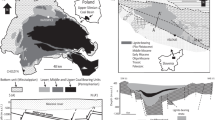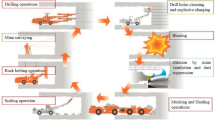Abstract
Surface coal mining creates more air pollution problems with respect to dust than underground mining . An investigation was conducted to evaluate the characteristics of the airborne dust created by surface coal mining in the Jharia Coalfield. Work zone air quality monitoring was conducted at six locations, and ambient air quality monitoring was conducted at five locations, for a period of 1 year. Total suspended particulate matter (TSP) concentration was found to be as high as 3,723 μg/m3, respirable particulate matter (PM10) 780 μg/m3, and benzene soluble matter was up to 32% in TSP in work zone air. In ambient air, the average maximum level of TSP was 837 μg/m3, PM10 170 μg/m3 and benzene soluble matter was up to 30%. Particle size analysis of TSP revealed that they were more respirable in nature and the median diameter was around 20 μm. Work zone air was found to have higher levels of TSP, PM10 and benzene soluble materials than ambient air. Variations in weight percentages for different size particles are discussed on the basis of mining activities. Anionic concentration in TSP was also determined. This paper concludes that more stringent air quality standards should be adopted for coal mining areas and due consideration should be given on particle size distribution of the air-borne dust while designing control equipment.
Similar content being viewed by others
References
Addis, M. C., Simons, I. G., & Smart, P. L. (1984). The environmental impact of opencast operation in the forest of Dean, England. Journal of Environmental Management, 19, 79–95.
Banerjee, S. K., Dhar, R. K., & Ghose, M. K. (1996). Air pollution due to coal washery projects and its abatement measures. Environmental Management, 20(2) 235–240.
Chadwick, M. J., Highton, N. H., & Lindman, N. (1987). Environmental impacts of coal mining and utilization (p. 295). England: Pergamon Press.
CMRS (1961). Dust problem due to washery, Central Mining Research Station, Dhanbad. Coal Council of India, 1963.
Cowherd, C. Jr. (1979). Measurements of fugitive dust emissions from haul roads. Report No. EPA-600/7–79–182, Research Triangle Park. NC: USEPA, Industrial Environmental Research Laboratory.
Fox, C. S. (1930). The Jharia Coalfield Memorandum. Geological Survey of India, p. 56.
Ghose, M. K. (1989). Pollution due to air borne dust particles in coal mining, its monitoring and abatement measures. Minetech, 10(1), 91–95.
Ghose, M. K., & Banerjee, S. K. (1995). Status of air pollution caused by coal washery project in India. Environmental Monitoring and Assessment, 38(19), 97–105.
Ghose, M. K., & Banerjee, S. K. (1997). Physico-chemical characteristics of the air borne dust emitted by coal washeries. Energy Environment Monitor, 13, 11–16.
Ghose, M. K., & Majee, S. R. (2000a). Status of air pollution in Indian opencast coal mines. Minetech, 21(2) , 48–52.
Ghose, M. K., & Majee, S. R. (2000b). Assessment of dust generation due to opencast coal mining- an Indian case study. Environmental Monitoring and Assessment, 6(2), 255–263.
Ghose, M. K., & Majee, S. R. (2000c). Assessment of impact on air environment due to opencast coal mining- an Indian case study. Atmospheric Environment, 34(17), 2791–2796.
Ghose, M. K., Majee, S. R., & Sinha, P. K. (1999). Monitoring and assessment of impact on air environment due to hard coke plant operation-an Indian case study. The International J Environmental Studies, 56(4), 1–8.
Ghose, M. K., & Sinha, D. K. (1990). Air pollution control plan in coal mining areas. Indian Journal of Environmental Protection, 10(10), 752–756.
IS:5182 (Part XII) (1974). Indian Standard Methods for the Measurement of Air Quality.
Kumar, U. (1995). Underground coal mining in India - challenges and prospects. Transactions MGMI, 92(1), 1–7.
Merefield, J. R., Stone, I., Roberts, J., Dean, A., & Jones, J. (1995). Monitoring air borne dust from quarrying and surface mining operations. Transactions Institutions of Mining and Metals (Section A: Mining Industry) 194, A76–78.
Nair, P. K., & Sinha, J. K. (1987). Dust control at deep hole drilling for open pit mines and development of a dust arrestor. Journal of Mines, Metals and Fuels, 35(8) 360–364.
Pless-Mulloi, T., Tate, J., Howel, D., Stone, I., & Merefield, J. (1995). Quantitative and qualitative monitoring of dust particles from opencast, Pittsburgh. Air and Waste Management Association, April 4–6.
Pless-Mulloli, T., King, A., Howel, D., Stone, I., & Merefield, J. (2000). PM10 levels in communities close to and away from opencast coal mining sites in Northeast England. Atmospheric Environment, 34, 3091–3101.
Author information
Authors and Affiliations
Corresponding author
Rights and permissions
About this article
Cite this article
Ghose, M.K., Majee, S.R. Characteristics of Hazardous Airborne Dust Around an Indian Surface Coal Mining Area. Environ Monit Assess 130, 17–25 (2007). https://doi.org/10.1007/s10661-006-9448-6
Accepted:
Published:
Issue Date:
DOI: https://doi.org/10.1007/s10661-006-9448-6




